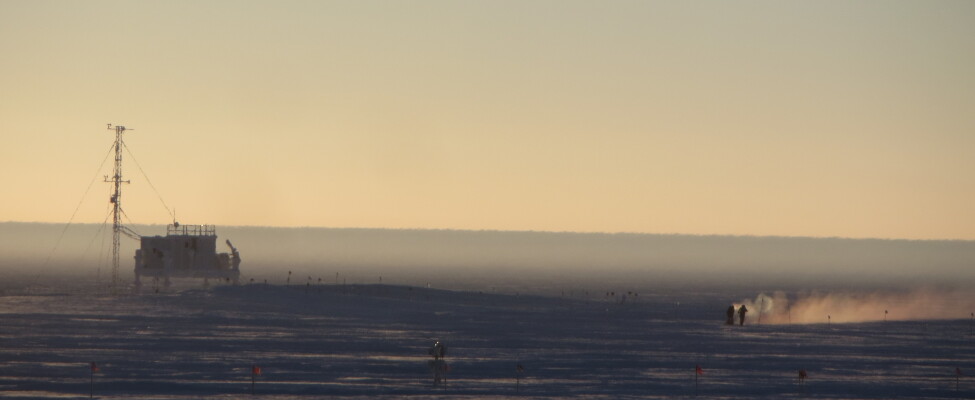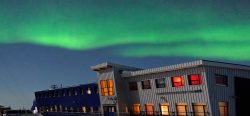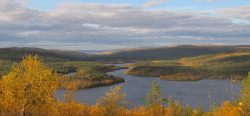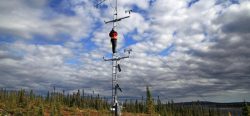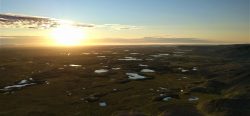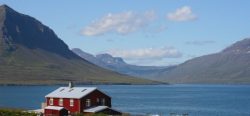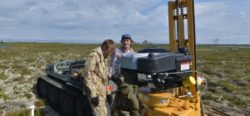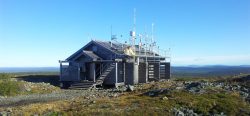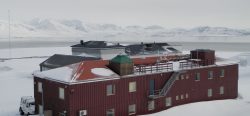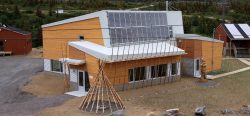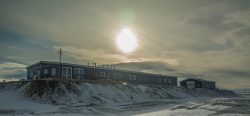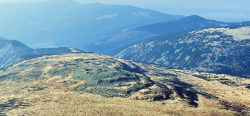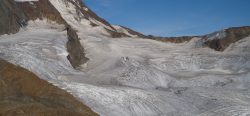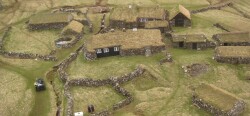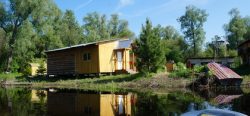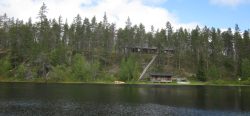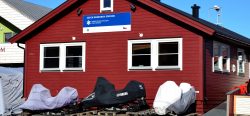STATION NAME AND OWNER
Summit Station is funded by the US National Science Foundation (NSF) and operated by Battelle ArcticDefinitions of the Arctic vary according to environmental, geographical, political, cultural and scientific perspectives. Some scientists define the Arctic as areas having a high latitude, long winters, short, cool summers,... More Research Operations (ARO) with guidance from the Science Coordination Office (SCO).
LOCATION
Summit Station (72°36’ N, 38°25’ W), is a research platform located near the apex of the Greenland ice sheetA mass of glacial land ice extending more than 50,000 square kilometers (20,000 square miles). The two ice sheets on Earth today cover most of Greenland and Antarctica and together... More, at an altitude of 3210 meters. It is located within Kalaallit Nunaanni nuna eqqissisimatitaq, or the Northeast Greenland National Park. This is the largest national park in the world, and it protects 972,000 square km of inland ice and glaciers as well as adjoining coastal land areas.
BIODIVERSITY AND NATURAL ENVIRONMENT
Summit Station is located in the high polar plateau of the Greenland ice sheetA mass of glacial land ice extending more than 50,000 square kilometers (20,000 square miles). The two ice sheets on Earth today cover most of Greenland and Antarctica and together... More. Minimal snow topography is present, and the nearest point of exposed land is approximately 400 km away. The station is in accumulationEncompasses all the ways in which a body of ice (a glacier or ice sheet) gains mass at its surface, such as snowfall and rime formation. However, it excludes ice... More zone of the ice sheetA mass of glacial land ice extending more than 50,000 square kilometers (20,000 square miles). The two ice sheets on Earth today cover most of Greenland and Antarctica and together... More, and experiences approximately 0.7 meters of snow accumulationEncompasses all the ways in which a body of ice (a glacier or ice sheet) gains mass at its surface, such as snowfall and rime formation. However, it excludes ice... More per year. The effective pressure altitude ranges from 11,000 to 13,000 feet. Temperatures range from -88 F in the winter to approximately 32 F in the summer. Wind speeds in the summer are generally mild, but can exceed 40 knots during storm events. In the wintertime, sustained wind speeds have been recorded in excess of 70 knots.
Summit Station offers access to a high-elevation, high-latitude, low-water-vapor, and year-round-supported location. This enables researchers to measure components of the earth system that would otherwise not be accessible. The facility is currently the highest elevation research station located north of the Arctic CircleA line of latitude currently at 66° 33? 44? (66.5622°) north of the Equator. It is the southern limit of the region of the Earth that experiences the 'midnight sun'.... More.
HISTORY AND FACILITIES
Summit Station was established for the collection of the Greenland Ice SheetA mass of glacial land ice extending more than 50,000 square kilometers (20,000 square miles). The two ice sheets on Earth today cover most of Greenland and Antarctica and together... More Project 2 (GISP2) ice core. At that time, seasonal campaigns were undertaken to measure atmospheric components, in order to improve the interpretation of the ice core records. Recognition of the value of observations at the site led to intensive measurement campaigns, and eventually continuous year-round staffed research activities since 2003. Summit Station has become a world-class ArcticDefinitions of the Arctic vary according to environmental, geographical, political, cultural and scientific perspectives. Some scientists define the Arctic as areas having a high latitude, long winters, short, cool summers,... More observatory as part of the ArcticDefinitions of the Arctic vary according to environmental, geographical, political, cultural and scientific perspectives. Some scientists define the Arctic as areas having a high latitude, long winters, short, cool summers,... More Observing Network (AON) and the International ArcticDefinitions of the Arctic vary according to environmental, geographical, political, cultural and scientific perspectives. Some scientists define the Arctic as areas having a high latitude, long winters, short, cool summers,... More Systems for Observing the Atmosphere (IASOA) network. The station facilities consist of a combination of permanent year-round science and operations structures, as well as seasonal structures to accommodate summertime research campaigns and maintenance. The station serves a seasonal population of up to 45 staff and researchers during the months of April – September, and a staff of 4-6 staff during October – March.
GENERAL RESEARCH AND DATABASES
A wide variety of research projects have been conducted at Summit Station since its establishment in 1989. Summit Station has developed into an interdisciplinary research hub supporting a wide range of scientific research on a year-round basis. The fields of meteorologyThe scientific study of the atmosphere and its phenomena, especially in relation to weather and weather forecasting.... More, glaciologyThe study of glaciers. More, atmospheric chemistryThe study of matter at the atomic and molecular scale.... More, and astrophysics are all represented. In addition to investigator-driven projects, Summit Station houses a LTO program committed to maintaining year-round measurements of key baseline variables of climate changeAccording to the United Nations Framework Convention on Climate Change, climate change is change in the climate of the whole Earth or a region of the Earth that is believed... More at the site.
A table of current measurements, publications and contacts by which to access Summit Station datasets can be found at the GEOSummit website: www.geo-summit.org
HUMAN DIMENSION
The nearest local community to Summit Station is Ilulissat at a distance of 593 km. The Summit Station research community collaborates with researchers in Greenland, Denmark, and across the world.
ACCESS
Research access to Summit Station is managed by the US National Science Foundation. Information on requesting access and logistical support is available at the Battelle ArcticDefinitions of the Arctic vary according to environmental, geographical, political, cultural and scientific perspectives. Some scientists define the Arctic as areas having a high latitude, long winters, short, cool summers,... More Gateway: https://battellearcticgateway.org/program-information
Researchers must also meet the science permitting requirements of the Government of Greenland.
Physical access for researchers and cargo is provided via Kangerlussuaq, Greenland, on Hercules LC-130 aircraft operated by the New York Air National Guard 109th Airlift Wing (NYANG-109), as well as other ski-equipped aircraft. A 4877-meter-long snow runway is groomed for summertime flight operations. The station can also be accessed via surface traverses.
